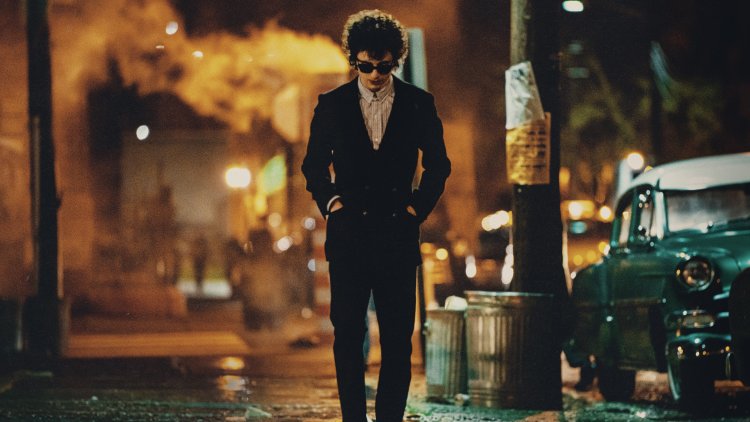Bob Dylan Broke Rules. <em>A Complete Unknown</em> Follows Them.
The biopic turns its subject’s independence and idiosyncrasies into the stuff of bland summary.

The gift of Bob Dylan’s music is to make the world seem weirder, or rather to reveal the world to be as strange as it really is. He sings of life as a flow of jumbled-up signs and sensations, some real and some not, carrying meaning beyond words. Even at his most strident, he wheezes out an anti-narrative: Thou shalt not simplify, classify, categorize.
A Complete Unknown, James Mangold’s biopic focused on the bard’s early career, understands this—and betrays it. The film portrays Dylan as a prophet bringing independence and idiosyncrasy to a world of rule-enforcers and followers. Timothée Chalamet does excellent work striking Dylan’s balance of unworldliness and humanity. Yet no movie about unconventionality should be as blandly conventional as this one is.
The problem starts at the level of conception. Mangold has chosen to examine the most chewed-over chapters of Dylan’s career: his early days in the New York City folk scene, beginning in 1961 and leading up to the 1965 Newport Folk Festival, when he shocked acoustic-guitar purists by going electric. Newsie cap on his head, Dylan blows into Greenwich Village at the film’s start, gigs around, and quickly wins the admiration of his idols—Woody Guthrie, Pete Seeger, Johnny Cash—as well as of the scene’s rising star, Joan Baez. Rebellion brings acclaim, which brings public expectations, which brings more rebellion: a cycle that’s true to Dylan’s life, but also that of many previous iconoclasts portrayed on film.
Mangold knows the rules of biopics well; his 2005 Cash exploration, Walk the Line, set the modern template for how to bend a complex individual’s life into a satisfying arc. Here, the director and his co-writer, Jay Cocks, diverge from the template in one intriguing way. Dylan’s habit of lying and misdirection has made the question of who the man born Robert Zimmerman really is, and why exactly he does what he does, one of music’s enduring mysteries. Rather than try to crack the case with backstory providing psychological cause and effect, A Complete Unknown just lets Dylan be … unknown. When he tells Baez that he used to be a carnie, she exasperatedly replies that he’s full of it. He may well be. But he’s living out an idea that he professes in a key bit of dialogue: To succeed onstage, you have to inspire the same fascination as a freak show.
[Read: Bob Dylan reveals himself through 66 songs]
Chalamet does just that. He plays Dylan with heavy-lidded stillness, making him seem perpetually on the verge of dozing off, mumbling as if in a dream. The film overflows with performance scenes in which Chalamet captures Dylan’s controlled erraticism, singing in a way that spins folk conventions into a galactic spiral of feeling. The real-life Dylan of the 1960s was a bit lighter and funnier than the solemn figure Chalamet cuts, but his prankster soul flashes through occasionally, such as when he announces himself to be God and then breaks into a grin. And though Dylan himself had some input in the movie, Chalamet doesn’t dull the artist’s cruel edge; at one point, with glassy anger in his eyes, he tells Baez her songs are pretty like paintings in a dentist’s office.
Unfortunately, the rest of the movie has that same antiseptic quality that Dylan stood against. New York looks as stagey and cheerful as an amusement park. Dylan’s romance with Sylvie Russo—a fictionalized version of his real-life girlfriend Suze Rotolo, played by Elle Fanning—mostly seems to exist to give trivia about Dylan’s love songs. Historical giants are sketched in 2-D: Ed Norton’s Seeger is a gentle idealist with a hint of cunning; Monica Barbaro’s Baez is all confidence except for when she’s all insecurity. Most irritating are the groan-worthy winks to the audience. “Be careful on that thing!” Seeger admonishes as Dylan rides his motorcycle, a few years before the singer’s career-altering, still-mysterious crash of 1966.
Thanks to Chalamet’s performance, the film’s hokiness isn’t totally fatal to the viewing experience. But if A Complete Unknown is Hollywood’s grand, Oscar-baiting summation of Dylan’s legacy, then the implication is sad: Even when trying to celebrate originality, the entertainment industry insists on predictability. The film need not be an art-house riddle—Todd Haynes already took that approach to Dylan in 2007 with I’m Not There—but a shaggier, more naturalistic version would have better suited its subject. The film does convey one true idea, at least: Worshipping an artist is different from listening to what they have to say.
What's Your Reaction?




















